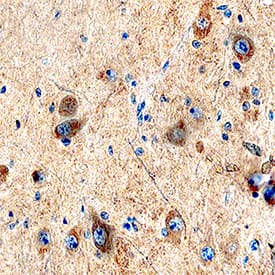Kallikrein 8/Neuropsin Products
The human tissue kallikrein (KLK) gene family contains 15 members that play important roles in cancer. Notably, kallikrein-1, also known as tissue kallikrein, cleaves kininogen to release the vasoactive kinin peptide, bradykinin or lysyl-bradykinin. Kallikrein-3, called prostate specific antigen (PSA), is an established tumor marker that aids in the diagnosis, staging, and follow up of prostate cancer. Kallikrein-4 is specifically expressed in the prostate and over-expressed in prostate cancer. Kallikrein-5 is widely expressed but found at high levels in skin, breast, brain and testis; over-expression is an indicator of poor prognosis in ovarian cancer. Kallikrein-8 is expressed in the brain and is a novel marker of ovarian and cervical cancer.
Human plasma kallikrein, a serine protease, is synthesized in the liver and circulates in the plasma bound to high molecular weight (HMW) kininogen or as a free zymogen. Once activated by its physiological activator, coagulation factor XII, it displays endopeptidase activity towards peptide bonds after arginine (preferred) and lysine. It cleaves HMW kininogen, its major physiological substrate, to release the potent vasodilator peptide bradykinin. It is also able to cleave a number of inactive precursor proteins to generate active products, such as plasminogen and prourokinase.
100 results for "Kallikrein 8/Neuropsin" in Products
100 results for "Kallikrein 8/Neuropsin" in Products
Kallikrein 8/Neuropsin Products
The human tissue kallikrein (KLK) gene family contains 15 members that play important roles in cancer. Notably, kallikrein-1, also known as tissue kallikrein, cleaves kininogen to release the vasoactive kinin peptide, bradykinin or lysyl-bradykinin. Kallikrein-3, called prostate specific antigen (PSA), is an established tumor marker that aids in the diagnosis, staging, and follow up of prostate cancer. Kallikrein-4 is specifically expressed in the prostate and over-expressed in prostate cancer. Kallikrein-5 is widely expressed but found at high levels in skin, breast, brain and testis; over-expression is an indicator of poor prognosis in ovarian cancer. Kallikrein-8 is expressed in the brain and is a novel marker of ovarian and cervical cancer.
Human plasma kallikrein, a serine protease, is synthesized in the liver and circulates in the plasma bound to high molecular weight (HMW) kininogen or as a free zymogen. Once activated by its physiological activator, coagulation factor XII, it displays endopeptidase activity towards peptide bonds after arginine (preferred) and lysine. It cleaves HMW kininogen, its major physiological substrate, to release the potent vasodilator peptide bradykinin. It is also able to cleave a number of inactive precursor proteins to generate active products, such as plasminogen and prourokinase.
| Source: | NS0 |
| Accession #: | O60259 |
| Applications: | EnzAct |
| Reactivity: | Human |
| Details: | Mouse IgG2a Kappa Monoclonal Clone #2F11 |
| Applications: | WB, ELISA, ICC/IF |
| Reactivity: | Human |
| Details: | Mouse IgG2 Monoclonal Clone #MM0434-6G15 |
| Applications: | IHC, WB |
Recombinant Monoclonal Antibody
| Reactivity: | Human |
| Details: | Rabbit IgG Monoclonal Clone #140 |
| Applications: | WB |
| Reactivity: | Human |
| Details: | Rabbit IgG Polyclonal |
| Applications: | IHC |
Recombinant Monoclonal Antibody
| Reactivity: | Human |
| Details: | Rabbit IgG Monoclonal Clone #140 |
| Applications: | WB |
| Reactivity: | Human |
| Details: | Rabbit IgG Polyclonal |
| Applications: | ELISA |
Recombinant Monoclonal Antibody
| Reactivity: | Human |
| Details: | Rabbit IgG Monoclonal Clone #038 |
| Applications: | ELISA |
| Applications: | WB |
| Applications: | ELISA |
| Reactivity: | Human |
| Details: | Rabbit IgG Polyclonal |
| Applications: | ELISA |
| Applications: | AC |
Recombinant Monoclonal Antibody
| Reactivity: | Human |
| Details: | Rabbit IgG Monoclonal Clone #038 |
| Applications: | ELISA |
Recombinant Monoclonal Antibody
| Reactivity: | Human |
| Details: | Rabbit IgG Monoclonal Clone #038 |
| Applications: | ELISA |
| Reactivity: | Human |
| Details: | Mouse IgG2 Monoclonal Clone #MM0434-6G15 |
| Applications: | IHC, WB |
| Reactivity: | Human |
| Details: | Rabbit IgG Polyclonal |
| Applications: | ELISA |
| Reactivity: | Human |
| Details: | Mouse IgG2 Monoclonal Clone #MM0434-6G15 |
| Applications: | IHC, WB |
Recombinant Monoclonal Antibody
| Reactivity: | Human |
| Details: | Rabbit IgG Monoclonal Clone #140 |
| Applications: | WB |
| Reactivity: | Human |
| Details: | Mouse IgG2 Monoclonal Clone #MM0434-6G15 |
| Applications: | IHC, WB |
Recombinant Monoclonal Antibody
| Reactivity: | Human |
| Details: | Rabbit IgG Monoclonal Clone #140 |
| Applications: | WB |
| Reactivity: | Human |
| Details: | Goat IgG Polyclonal |
| Applications: | WB, Neut |
| Reactivity: | Human |
| Details: | Mouse IgG2b Monoclonal Clone #189004 |
| Applications: | WB, IHC, ICC |
| Reactivity: | Human |
| Details: | Rat IgG1 Monoclonal Clone #369910 |
| Applications: | IP, Neut |
| Reactivity: | Human |
| Details: | Mouse IgG2 Monoclonal Clone #MM0434-6G15 |
| Applications: | IHC, WB |
| Reactivity: | Human |
| Details: | Mouse IgG2 Monoclonal Clone #MM0434-6G15 |
| Applications: | IHC, WB |



![Western Blot: Kallikrein 8/Neuropsin Antibody (2F11) [H00011202-M01] Western Blot: Kallikrein 8/Neuropsin Antibody (2F11) [H00011202-M01]](https://resources.bio-techne.com/images/products/Kallikrein-8-Neuropsin-Antibody-2F11-Western-Blot-H00011202-M01-img0007.jpg)
![Immunohistochemistry-Paraffin: Kallikrein 8/Neuropsin Antibody (MM0434-6G15) - Azide and BSA Free [NBP2-11754] Immunohistochemistry-Paraffin: Kallikrein 8/Neuropsin Antibody (MM0434-6G15) - Azide and BSA Free [NBP2-11754]](https://resources.bio-techne.com/images/products/Kallikrein-8-Neuropsin-Antibody-MM0434-6G15-Immunohistochemistry-Paraffin-NBP2-11754-img0001.jpg)
![Western Blot: Kallikrein 8/Neuropsin Antibody (140) [NBP2-89988] Western Blot: Kallikrein 8/Neuropsin Antibody (140) [NBP2-89988]](https://resources.bio-techne.com/images/products/Kallikrein-8-Neuropsin-Antibody-140-Western-Blot-NBP2-89988-img0001.jpg)
![Immunohistochemistry-Paraffin: Kallikrein 8/Neuropsin Antibody [NBP3-05517] Immunohistochemistry-Paraffin: Kallikrein 8/Neuropsin Antibody [NBP3-05517]](https://resources.bio-techne.com/images/products/Kallikrein-8-Neuropsin-Antibody-Immunohistochemistry-Paraffin-NBP3-05517-img0003.jpg)

![Western Blot: Kallikrein 8/Neuropsin Overexpression Lysate [NBL1-12357] Western Blot: Kallikrein 8/Neuropsin Overexpression Lysate [NBL1-12357]](https://resources.bio-techne.com/images/products/KLK8-Overexpression-Lysate-Adult-Normal-Western-Blot-NBL1-12357-img0002.jpg)
![ELISA: Human Kallikrein 8/Neuropsin ELISA Kit (Colorimetric) [NBP2-62176] ELISA: Human Kallikrein 8/Neuropsin ELISA Kit (Colorimetric) [NBP2-62176]](https://resources.bio-techne.com/images/products/Human-Kallikrein-8-Neuropsin-ELISA-Kit-Colorimetric-ELISA-NBP2-62176-img0001.jpg)
